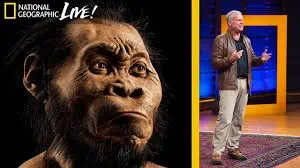Homo naledi culture or some other spectacular find being hinted at by NatGeo Explorer Lee Berger in recent interviews, on Twitter
 Lee Berger has been dropping hints for weeks. Now he’s explicitly stating, stay tuned for something big about to come out.
Lee Berger has been dropping hints for weeks. Now he’s explicitly stating, stay tuned for something big about to come out.
Dr. Berger was a guest on Australian Radio on March 20. He was in Brisbane, Australia for a paleo-anthropology conference, the World Science Festival, March 24-26:
Professor Lee Berger has been leading some of the most revolutionary explorations, with ground-breaking expeditions across Africa. He joins Brian Greene to discuss the major discoveries of the last two decades in the search for human origins.
He did a series of interviews in Brisbane and prior to the trip. Berger Tweeted out on March 21:
I’ll drop this. Some #eastereggs hidden in this conversation with @SarahKonowski @abcconvos
From ABCConvos:
 National Geographic Explorer in Residence, Lee Berger, entered the field of palaeoanthropology when there was a one in 10,000,000 chance he would discover anything worthwhile digging around South Africa.
National Geographic Explorer in Residence, Lee Berger, entered the field of palaeoanthropology when there was a one in 10,000,000 chance he would discover anything worthwhile digging around South Africa.
But this real-life Indiana Jones kept bucking the odds.
First, he found a pair of hominid teeth in southern Africa, and then after a fossil hunting dry spell, his 9-year-old son Matthew found the jawbone of a completely new hominid species.
Interestingly, Berger stated on Twitter that of all the interviews he has ever given in these past few decades, he found this one to be the absolute best.
He continues, towards the end of the interview:
You know there’s no definition of human… look it up right now. Have your people Google it. You’ll get something ridiculous, like having the characteristics of a people or a person.
My colleagues and I, more than 150 scientists involved, believe, we may have that outgroup.
They [Homo naledi] are bipedal. So they’re hominins… they have a tiny brain. They’re not adapting to the world the way we are. They are a form of an outgroup. And we’ve begun to find culture.
Konowski: So, what else?
 I announced in December, that we found fire. Within the next couple of months you are going to see extraordinary discoveries that we made. We’re on the verge of for the first time in human history being able to examine, a non-human species with culture.
I announced in December, that we found fire. Within the next couple of months you are going to see extraordinary discoveries that we made. We’re on the verge of for the first time in human history being able to examine, a non-human species with culture.
Konowski: [Gasp]
Berger goes on to say the discoveries will be out “within the next few weeks.” He then adds, “actually, I was hoping it’d be out by the time I took this trip [to Australia].
Note – Berger has been letting his frustration known for weeks on the slowness of the paper’s publication, both in interviews and on social media.
 See our article from January, “Homo naledi paper to be published, stunning reversal: Lee Berger threatened Science Magazine to go public.” The journal has been stalling publication of Berger’s paper for unspecified reasons.
See our article from January, “Homo naledi paper to be published, stunning reversal: Lee Berger threatened Science Magazine to go public.” The journal has been stalling publication of Berger’s paper for unspecified reasons.
Australian Paleo-anthropologist Michael Petraglia reiterated Berger’s point on the exciting announcement in a Tweet March 28:
“There are indeed exciting things to come — though lots of science required.”
“This is pretty insane”
At least one Twitter user has ventured a guess (Replying to Lee Berger March 23):
An unknown hominid species with a rich culture. Before humans developed one. This is pretty insane. Looking forward to the actual announcement.
Berger, already regarded as one of the very top, if not thee top paleo-anthropologists in the world, just received another promotion.
From National Geographic, March 15,
National Geographic Society Names Lee Berger Explorer in Residence
 The National Geographic Society announced today that world-renowned paleoanthropologist Lee Berger has been named a National Geographic Explorer in Residence.
The National Geographic Society announced today that world-renowned paleoanthropologist Lee Berger has been named a National Geographic Explorer in Residence.
Berger’s relationship with the Society began with his first grant in 1996 for the excavation and preservation of early Homo sapiensfootprints at Saldanha Bay in South Africa, but he is best known for his work at the Cradle of Humankind World Heritage Site in South Africa. With support from the Society and Lyda Hill Philanthropies, his excavations there have led to some of the most significant scientific findings of the 21st century, including the finding and documentation of two previously unknown hominin species: Australopithecus sediba in 2008 at the Malapa site and Homo nalediin 2013 in the Rising Star cave system.
Berger has a new book scheduled to come out in May (Available for Pre-order at Amazon), co-authored with his friend and colleague John Hawks. From the description:
Join Berger on the adventure of a lifetime as he explores the Rising Star cave system and begins the complicated process of explaining these extraordinary finds—finds that force a rethinking of human evolution, and discoveries that Berger calls “the Rosetta stone of the human mind.”
Editor’s note – Good intro video to Homo naledi by our friend conservative-leaning Stefan Milo at YouTube.



Anything we say about naledi now will probably be obsolescent when the full salvo of Berger’s claims come to bear. But this is now.
“Nobody’s been able to define ‘human’,” Berger says — and then he goes on to claim Homo naledi is “non-human.”
Say what?
Now, anthropologists, philosophers and effete artistes have been attempting to sharpen their notion of what it means to be “human” since forever.
In the scientific community they started out with “Man is the only animal that uses and makes tools.” But that sort of fell by the wayside when they found oops they hadn’t been looking closely enough at the animal kingdom. Others are and were quite accomplished.
“Humans are the bipedal ape” was the refrain echoed for many decades. It became the holy grail — find a biped and you’ve automatically found a human ancestor. Except…now we’ve dug up more biped primates than we know what to do with, chronology and morphology shattered that illusion. It wasn’t an unreasonable first theory given that all of the surviving apes are quadrupeds, but it ignored the simple truth that humans attack, eat or screw to death any travelers in their lane — and sometimes all on the same date.
It turns out that bipedalism is a feature of humanity, not its defining component. Primate bipeds could be human ancestors but it’s more likely they’re not in the royal line. That’s been uncomfortably obvious for a half-century (see Lucy). But even today some researchers don’t seem to want to wrap their head around that just because your fossil walked on two legs that doesn’t mean you’ve discovered the missing link.
“Only humans are capable of symbolic thought.” Turns out Neanderthals and Denisovans were doing it for tens of thousands if not hundreds of thousands of years before sapiens hit the scene. Koko was unavailable for comment.
“Only Homo sapiens bury their dead.” Er, nope.
“Man is the master of fire.” Yeah, a million years after Homo erectus. And the hobbit. And now maybe naledi dudes with a brain the size of a softball.
“Humans are the only creatures that pass on their knowledge by culture.” Hopefully better than the oral history of Kunta Kinte.
But don’t point to a small dent in the wall with a few cranial shards and tell me it’s proof of a mausoleum. Convince us that the charcoal in the cave wasn’t from later explorers. Point to an unambiguous tool, any tool at all. You’ve had thousands of bone fragments and a decade, publish a genome.
We’ll be the judge, not National Geographic.
Oh gee, I can’t wait to see what bogus claims he makes this time.
Australopithcus naledi is no human ancestor, and that little brain didn’t discover, nor use, fire.
It’s looking more and more like The Great Homo Naledi Reveal includes the claim that they persisted in the cave system until around 10,000 years ago.
This would, of course, be the greatest paleoanthropology coup of all time and might explain why National Geographic now wants front seat aboard the Lee Berger train.
https://www.youtube.com/watch?v=mWh7vM6maWk
at 1:03:50
Highly informative Q&A starts at 57:00
“Watch us on Netflix in May or June,” John Hawks says.
Tim White is either going to stroke out or bend the knee a broken man. ooh boy
Homo naledi findings being haggled out behind closed doors might well be related to tools.
Even though Berger hasn’t–yet–announced the finding of tools, he has claimed advanced culture and fire.
Every other hominin demonstrating culture and fire has exercised advanced stone tool use, so it is not unreasonable to think that naledi also did.
Look at that in the context of other recent findings disrupting established thought on tools. They are now finding Oldowan tools going back 3.3 million years, predating humans. They’re now finding that today’s macaques produce “Oldowan” artifacts.
Now if you also have a 600cc hominin (naledi) using advanced stone tools, why couldn’t any of the other micro-brained hominins in the fossil record have done it as well?
This new sum of evidence would tear the fabric of the paleoanthropology establishment. Its presumption has always been that Homo specimens in strata can be reliably associated with the tools lying thereabouts. Research, methods, theories, entire careers have been based on such assumptions.
Advanced naledi stone tools could invalidate that and subject it all to doubt.
Even if Berger were to provide unassailable proof of such claims, he’d still have to wade hip-deep through the bodies of incoming kamikaze colleagues. And some will hate him for it.
I didn’t even mention Homo floresiensis. Think about the paleobureaucratic stink still coming off of that. Even today you hear the wails of anguish: pygmies!, microcephalics!, nutritional defects!, retards!, deformed cretins!, incesters!, just island dwarfs!
Why?
Homo floresiensis was a micro-brained hominin (400cc!) who hunted, used fire and stone tools, and was successful for many hundreds of thousands of years in ecology later enjoyed by sapiens.
The implications of floresiensis findings have been muted because by golly they’re just weird outliers we’d as soon forget, move along move along.
You can’t do that with naledi. They’re sitting smack in the middle of a UNESCO “Cradle of Humankind” world preserve. Other mainstream hominins litter the territory. And they’ve come in sequence after floresiensis, after luzonensis, this baby makes “outlier” number three.
If naledi used stone tools, mastered fire, and practiced identifiable culture, the invested academic establishment cannot simply dismiss it. And the obsolete narratives must die.
Other Berger tidbits that have dribbled out: “hand-baked clay” and paleo excavations within 200 meters of the caves. Find a naledi tooth or some such among stone tools anywhere and we’re off to the races. . . .
I keep seeing comments from paleo dudes about how flabbergasting it is that Homo naledi would occupy the same ecological niche as more advanced hominins. It’s true, for extended stretches they seem to be contemporaneous in Africa with the boys in Jebel Irhoud and Homo heidelbergensis/rhodesiensis closer by.
I keep hearing, “There are no protective barriers, nothing in the landscape to keep them from being out-competed. How can this be?”
Huh? What do you think the Dinaledi cave system is? Even if naledi weren’t full-time mole people it doesn’t seem outrageous to see them using their smaller size and the labyrinth as a Pleistocene Masada.